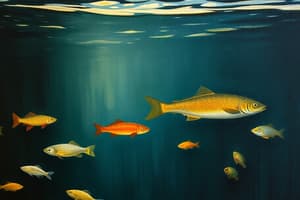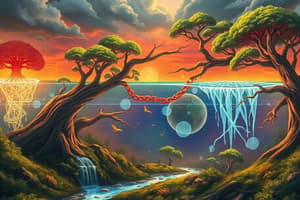Podcast
Questions and Answers
Food chains reveal how ______ flows through ecosystems
Food chains reveal how ______ flows through ecosystems
energy
In a food chain, producers are nourished by ______
In a food chain, producers are nourished by ______
sunlight
Primary consumers feed on ______
Primary consumers feed on ______
producers
Carnivores prey on ______ in a food chain
Carnivores prey on ______ in a food chain
Decomposers break down dead organic matter to release ______ back into the environment
Decomposers break down dead organic matter to release ______ back into the environment
An ecosystem may also contain decomposers, such as bacteria and fungi, breaking down waste and releasing nutrients back into the ______.
An ecosystem may also contain decomposers, such as bacteria and fungi, breaking down waste and releasing nutrients back into the ______.
Energy loss occurs during each transfer up the food chain due to various factors like digestion, respiration, growth, and ______.
Energy loss occurs during each transfer up the food chain due to various factors like digestion, respiration, growth, and ______.
Only a small percentage of energy reaches higher trophic levels, explaining why fewer individuals occupy higher positions in a food chain compared to ______ ones.
Only a small percentage of energy reaches higher trophic levels, explaining why fewer individuals occupy higher positions in a food chain compared to ______ ones.
At the end of the chain, when energy dissipates beyond recovery, it enters detrital food webs, passing through decomposer communities before returning to the ______ realm.
At the end of the chain, when energy dissipates beyond recovery, it enters detrital food webs, passing through decomposer communities before returning to the ______ realm.
Most real-world ecosystems exhibit complexity, characterized by multiple interconnected food web cycles that incorporate diverse interactions among species, ensuring resilience against challenges posed by environmental fluctuations, invasive species introductions, or ______ changes.
Most real-world ecosystems exhibit complexity, characterized by multiple interconnected food web cycles that incorporate diverse interactions among species, ensuring resilience against challenges posed by environmental fluctuations, invasive species introductions, or ______ changes.
Flashcards are hidden until you start studying
Study Notes
Understanding Science through Food Chains
Food chains are fundamental concepts within biology, revealing how energy flows through ecosystems. They help us comprehend complex relationships between living organisms and the environments they inhabit. Let's delve into this essential aspect of science by exploring what food chains are and their significance in our understanding of life’s intricacies.
What is a Food Chain?
A food chain depicts a linked sequence of consumers feeding directly upon producers or each other, forming a linear pathway. In its simplest form, it can begin with sunlight nourishing green plants (producers) via photosynthesis, which herbivores subsequently consume. Carnivores then prey on these herbivores, while decomposers break down dead organic matter to release nutrients back into the environment. Each link in this chain represents a transfer of energy from one level to another—a process known as trophic levels.
Trophic Levels
Trophic levels quantify the flow of energy through ecological systems. They consist of four primary groups: producer, primary consumer, secondary consumer, and tertiary consumer. Producers obtain energy from the sun and synthesize it into chemical forms, serving as the foundational base for all food chains. Primary consumers eat producers, secondary consumers feed on primary consumers, and so forth upwards until reaching top predators. An ecosystem may also contain decomposers, such as bacteria and fungi, breaking down waste and releasing nutrients back into the soil.
Energy Flow
Energy loss occurs during each transfer up the food chain due to various factors like digestion, respiration, growth, and reproduction. Therefore, only a small percentage of energy reaches higher trophic levels. This principle underlines why fewer individuals occupy higher positions in a food chain compared to lower ones. At the end of the chain, when energy dissipates beyond recovery, it enters detrital food webs, passing through decomposer communities before returning to the abiotic realm.
Complexity
While simple examples of food chains occur, most real-world ecosystems exhibit complexity, characterized by multiple interconnected food web cycles. These networks incorporate diverse interactions among species, ensuring resilience against challenges posed by environmental fluctuations, invasive species introductions, or climatic changes.
In summary, food chains illustrate the structure of energy flow in ecosystems and reveal critical interactions between different members of biological communities. Our exploration of this core concept reinforces our comprehension of science and bolsters our appreciation of nature's orderly beauty.
Studying That Suits You
Use AI to generate personalized quizzes and flashcards to suit your learning preferences.




